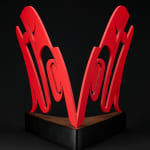-
Artworks
ROBERT DAVIDSON (GUUD SANS GLANS), O.C., O.B.C., (1946-) HAIDA, MASSET / WHITE ROCK
Yaahl Kiingnganggang (Raven Calling), 2004epoxy powdered coated aluminum, 21.5 x 17.5 x 20 in (54.6 x 44.5 x 50.8 cm), measurements reflect the dimensions of the work with the affixed wood and acrylic base.
numbered, signed with initials and dated to an affixed metal plate, "6/12 ЯD / 04".LOT 17
ESTIMATE: $7,000 — $10,000
PRICE REALIZED: $9,600.00Further images
Since the late 1990s Robert Davidson has moved “beyond” Haida art into a more universal abstract, modernist style suited to contemporary tastes. Karen Duffek notes that Davidson’s interest in abstraction was inspired by his study of certain 19th century painted feast dishes in the early 1980s [1]. Davidson began to liberate formlines – ovoids, U-forms, “tri-neg” shapes – from subject matter.
With Yaahl Kiingnganggang (Raven Calling) the raven form is abstracted but still clearly discernible. Based on a then brand new larger version exhibited in the 2004 show, Robert Davidson: The Abstract Edge, this striking sculpture brings to mind similar raven heads seen in wood sculptures and paintings by Davidson [2]. The bold aluminum lines are crisp but fluid, the forms and lines are what we have come to expect from this master of Haida art. The symmetry and mirrored image, too, are not incongruous to the style. We love the interplay of the profiles seen one through the other. The sculpture beautifully combines the traditions and expectations of Haida art with the modernity of a contemporary working artist.
Karen Duffek, the editor and essayist for The Abstract Edge, discusses this duality in Davidson’s works, and as part of her conclusion states that “he has chosen both to challenge and to work within the space of his inherited tradition.” And she leaves the last word to Davidson himself: “If we look back over the past two hundred years of Haida History, we can see a definitive progression in the art form. Who knows where the art will go from here? The limitation is really up to the artist in the present moment” [3]. Yaahl Kiingnganggang (Raven Calling) is the perfect embodiment of these ideas.
1. Karen Duffek, Robert Davidson: The Abstract Edge, 2004, p. 17.
2. Ibid., pp. 36-37.
3. Ibid., p. 45.
Since the late 1990s Robert Davidson has moved “beyond” Haida art into a more universal abstract, modernist style suited to contemporary tastes. Karen Duffek notes that Davidson’s interest in abstraction was inspired by his study of certain 19th century painted feast dishes in the early 1980s [1]. Davidson began to liberate formlines – ovoids, U-forms, “tri-neg” shapes – from subject matter.
With Yaahl Kiingnganggang (Raven Calling), the raven form is abstracted but still clearly discernible. Based on a then brand new larger version exhibited in the 2004 show Robert Davidson: The Abstract Edge, this striking sculpture brings to mind similar raven heads seen in wood sculptures and paintings by Davidson [2]. The bold aluminum lines are crisp but fluid, the forms and lines are what we have come to expect from this master of Haida art. The symmetry and mirrored image, too, are not incongruous to the style. We love the interplay of the profiles seen one through the other. The sculpture beautifully combines the traditions and expectations of Haida art with the modernity of a contemporary working artist.
Karen Duffek, the editor and essayist for The Abstract Edge, discusses this duality in Davidson’s works, and as part of her conclusion states that “he has chosen both to challenge and to work within the space of his inherited tradition.” And she leaves the last word to Davidson himself: “If we look back over the past two hundred years of Haida History, we can see a definitive progression in the art form. Who knows where the art will go from here? The limitation is really up to the artist in the present moment” [3]. Yaahl Kiingnganggang (Raven Calling) is the perfect embodiment of these ideas.
1. Duffek, Robert Davidson: The Abstract Edge, 2004, p. 17.
2. Ibid., pp. 36-37.
3. Ibid., p. 45.
References: A larger version of this work was exhibited in Vancouver, Museum of Anthropology, Robert Davidson: The Abstract Edge, 22 June 2004 - 30 January 2005, written about in show's exhibition catalogue, Karen Duffek, Robert Davidson: The Abstract Edge, (Vancouver: Museum of Anthropology at the University of British Columbia), 2004, pp. 44-46. For a smaller example by the artist see Walker’s Auctions, Nov. 2017, Lot 173.
Provenance
Private Collection, Toronto;
by descent to the present Private Collection, Toronto.
Join our mailing list
* denotes required fields
We will process the personal data you have supplied in accordance with our privacy policy (available on request). You can unsubscribe or change your preferences at any time by clicking the link in our emails.










